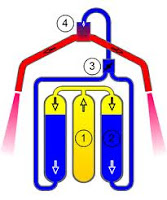Aim of this aircraft is to reduce long-distance flights for example. From Brussels to Sydney, to less than 2 to 4 hours.
 Achieving this goal intrinsically requires a new flight regime for commercial transport with Mach numbers ranging from 4 to 8. To fulfill its mission, a hyper-sonic aircraft with near antipodal range (20,000 km) is required. To achieve the range requirement liquid hydrogen fuel is mandatory since the specific calorific energy of hydrocarbon fuels would be too low. Here is an example of the applicability of REL's SABRE engine and lightweight heat ex-changer technology to Mach 5 cruise, REL is presently engaged on an EU 50% funded project as part of Framework 6 called LAP-CAT Long-term Advanced Propulsion Concepts and Technologies.
Achieving this goal intrinsically requires a new flight regime for commercial transport with Mach numbers ranging from 4 to 8. To fulfill its mission, a hyper-sonic aircraft with near antipodal range (20,000 km) is required. To achieve the range requirement liquid hydrogen fuel is mandatory since the specific calorific energy of hydrocarbon fuels would be too low. Here is an example of the applicability of REL's SABRE engine and lightweight heat ex-changer technology to Mach 5 cruise, REL is presently engaged on an EU 50% funded project as part of Framework 6 called LAP-CAT Long-term Advanced Propulsion Concepts and Technologies. This study is to examine the propulsion concepts and technologies required. The A2 vehicle, which is designed to be propelled by the Scimitar engine, has exceptional range (ca. 20,000 km both subsonic and supersonic) and is therefore able to service a large number of routes whilst simultaneously avoiding supersonic over flight of populated areas and the related sonic booms that can be heard on the ground. Its good subsonic performance enables it to service conventional subsonic overland routes.
This study is to examine the propulsion concepts and technologies required. The A2 vehicle, which is designed to be propelled by the Scimitar engine, has exceptional range (ca. 20,000 km both subsonic and supersonic) and is therefore able to service a large number of routes whilst simultaneously avoiding supersonic over flight of populated areas and the related sonic booms that can be heard on the ground. Its good subsonic performance enables it to service conventional subsonic overland routes. The configuration A2 Mach 5 Civil Transport To complement the Scimitar engine, REL has proposed a suitable vehicle configuration (A2) that attains the necessary subsonic and supersonic lift/drag ratio for efficient commercial operation. The air-frame is designed to have adequate control authority about all axes to handle engine-out and to achieve pitch trim over the full Mach range. In addition the air-frame configuration is an efficient structural shape with circular cross section hydrogen tank-age and uninterrupted carry-through wing spars. The vehicle is sized to carry 300 passengers since this is typical of future supersonic transport designs and thought to be the minimum to achieve a competitive seat/mile cost.
The configuration A2 Mach 5 Civil Transport To complement the Scimitar engine, REL has proposed a suitable vehicle configuration (A2) that attains the necessary subsonic and supersonic lift/drag ratio for efficient commercial operation. The air-frame is designed to have adequate control authority about all axes to handle engine-out and to achieve pitch trim over the full Mach range. In addition the air-frame configuration is an efficient structural shape with circular cross section hydrogen tank-age and uninterrupted carry-through wing spars. The vehicle is sized to carry 300 passengers since this is typical of future supersonic transport designs and thought to be the minimum to achieve a competitive seat/mile cost. As the air-frame of the A2 also has technology commonality with the SKYLON launch vehicle. The main difference is that the A2 air-frame is not designed for re-entry however it has to withstand prolonged flight at Mach 5 for several hours.
As the air-frame of the A2 also has technology commonality with the SKYLON launch vehicle. The main difference is that the A2 air-frame is not designed for re-entry however it has to withstand prolonged flight at Mach 5 for several hours.Although not examined in detail it is anticipated that the A2 airframe would be constructed as a similar multi-layer structure to SKYLON except with the addition of an actively cooled internal screen to intercept the heat leak from the hot aerodynamic-shell. Cruse at Mach 0.9 Lift/Drag 11.0 (5.9 km altitude) SFC 96.0 kN/kg/s Mach 5.0 cruise Lift/Drag 5.9 (25-28 km altitude) SFC 40.9 kN/kg/s Take-off sideline noise @450m 101.9 dBA . Distance 18700km Flight time 4.5 hours’under restrictive air-traffic controls conditions reserved range 5000km at mach 0.9 pay load 300 passengers (plus their baggage).
REL have conceived the Scimitar pre-cooled engine, a derivative SABRE engine, which exploits the unique thermodynamic properties of liquid hydrogen by using REL's lightweight heat ex-changers.
This engine is capable of sustained Mach 5 flight whilst achieving an effective exhaust velocity of the order of 40,900 m/s. In addition the engine has a second operating mode that features a high bypass airflow permitting efficient subsonic flight and moderate take-off noise.
.jpg) The incorporation of lightweight heat ex-changers in the main thermodynamic cycles of these engines is a new feature to aerospace propulsion and allows a cruising speed twice that of a jet engine. Both SABRE and Scimitar engines are designed around existing technologies from gas turbines, rockets and subsonic ramjets. As Scimitar is designed for sustained Mach 5 cruise it is designed for much longer life than SABRE engines designed for space access.
The incorporation of lightweight heat ex-changers in the main thermodynamic cycles of these engines is a new feature to aerospace propulsion and allows a cruising speed twice that of a jet engine. Both SABRE and Scimitar engines are designed around existing technologies from gas turbines, rockets and subsonic ramjets. As Scimitar is designed for sustained Mach 5 cruise it is designed for much longer life than SABRE engines designed for space access.






























0 comments:
Post a Comment